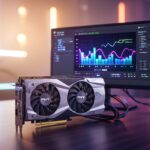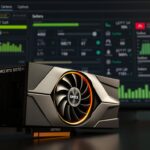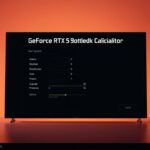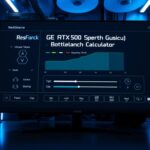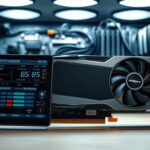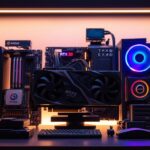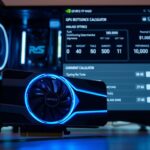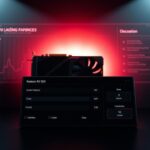Last Updated on August 11, 2025 by Gill
Remember that mix of excitement and nerves when upgrading your PC for the first time? That’s exactly how many feel about graphics card firmware updates. I’ve been there – staring at performance graphs, wondering if tweaking my hardware could push those extra frames in Cyberpunk 2077.
Modern gaming rigs hold untapped potential. Updating your card’s core software can boost clock speeds and power thresholds, much like tuning a high-performance engine. But here’s the truth: one wrong move could leave you with an expensive paperweight.
This isn’t about reckless modifications. With today’s streamlined utilities and clear protocols, enthusiasts can safely enhance their systems. Brands like NVIDIA and AMD now design their products with customization in mind, though proper precautions remain essential.
We’ll walk through the smart approach to firmware adjustments – from identifying compatible versions to creating emergency recovery plans. You’ll learn why double-checking power connections matters as much as choosing the right software toolkit, and how community forums became the unsung heroes of hardware optimization.
The journey from cautious beginner to confident tweaker starts with understanding both the rewards and risks. Let’s ensure your next gaming session benefits from every ounce of your hardware’s capability.
Introduction to GPU BIOS Flashing
Custom firmware modifications for graphics hardware open new possibilities for performance enthusiasts. By replacing factory settings with optimized vbios files, users can push their hardware beyond stock limitations. This process adjusts critical parameters like voltage thresholds and thermal management systems.
Modern graphics cards come with locked power budgets to ensure stability. Modified firmware unlocks these restrictions, allowing higher clock speeds and better thermal performance. Enthusiasts often discover 10-15% gains in demanding games through these adjustments.
| Aspect | Stock Settings | Custom vBIOS |
|---|---|---|
| Power Limit | 100% | 115-130% |
| Core Clock | Factory preset | +50-150 MHz |
| Fan Control | Basic curves | Custom profiles |
A lot of people explore firmware changes when standard overclocking hits plateaus. Aging hardware particularly benefits from these tweaks, breathing new life into older components. Community-developed tools like NVFlash have simplified the process significantly.
While powerful, this method requires careful research. Always verify compatibility between firmware versions and specific card models. Successful modifications can transform mid-range hardware into surprisingly capable performers.
Understanding GPU BIOS and Its Role in Performance
Your graphics card’s hidden potential lies in its bios settings. This firmware acts as the command center, managing everything from startup routines to performance thresholds. Think of it as the conductor of an orchestra – every component follows its instructions.
Manufacturers set conservative power limits to ensure stability across all units. These restrictions often bottleneck core clocks and memory clocks during intense gaming sessions. Custom firmware bypasses these limitations, letting your hardware stretch its legs.
| Performance Metric | Stock BIOS | Custom BIOS |
|---|---|---|
| Power Draw | 320W | 380W |
| Core Clock Boost | 1.7 GHz | 1.95 GHz |
| Thermal Performance | 84°C | 78°C |
| Cyberpunk 2077 FPS | 58 | 67 |
Even powerful cards like the RTX 3080 struggle with newer titles. Modified bios settings can squeeze out 15% better performance in Alan Wake 2 or Indiana Jones adventures. This hardware-level tuning outperforms basic software tweaks by addressing voltage regulation directly.
While exciting, these changes require careful planning. Always verify your card’s cooling capacity before raising power limits. The right adjustments transform aging hardware into capable performers, bridging the gap between upgrades.
How to Flash GPU BIOS Safely
Ever wonder why some tech enthusiasts hesitate before tweaking their hardware’s core software? The answer lies in preparation. Custom firmware adjustments demand more than technical skill – they require strategic decision-making.
Finding the right bios version often consumes 70% of the process. Unlike standard driver updates, modified firmware must match your exact card model and memory configuration. A mismatch could trigger instability or permanent damage.
| Factor | Stock Setup | Modified Setup |
|---|---|---|
| Preparation Time | 15 minutes | 2-4 hours |
| Risk Level | Low | High |
| Performance Gain | 0-5% | 8-18% |
Three critical questions determine readiness: Do you have a backup device? Have you benchmarked your current setup through rigorous test runs? Can you afford potential downtime?
Many discover their existing hardware performs adequately after proper optimization. Overclocking tools and cooling adjustments often resolve performance gaps without firmware risks. Save modifications for specialized use cases like competitive benchmarking.
Successful bios changes rely on verified tools and community-vetted files. Always cross-reference forums for your specific card model before proceeding. In rare case scenarios, recovery options exist – but prevention remains the best strategy.
Preparing Your GPU for a BIOS Update
What separates a smooth firmware upgrade from a hardware headache? Preparation. Think of your stock bios as a blueprint – losing it means losing your roadmap home if things go sideways.

Your Digital Safety Net
Grab NVFlash before touching anything. This tool creates a carbon copy of your current bios in seconds. Store this file in two locations: your desktop and a USB drive. Many discover this backup saves their card when experimental firmware causes black screens.
Matchmaking for Hardware
Not all boards play nice. TechPowerUp’s database reveals which designs share DNA with your hardware. Compare three key specs:
| Feature | Reference Model A | Reference Model B |
|---|---|---|
| PCI-E Power | 8+6 pin | 8+8 pin |
| Display Ports | 3 | 4 |
| Fan Configuration | Dual axial | Triple blower |
Mismatched power connectors strain PSUs. Different display port layouts confuse monitor handshakes. Stick to identical twins when choosing donor firmware.
Double-check the version number against your card’s PCB revision. A single digit difference can brick components. Smart prep work turns risky procedures into routine maintenance.
Step-by-Step Guide to Flashing GPU BIOS
Precision transforms firmware adjustments from daunting to manageable. Let’s explore the practical workflow for modifying your hardware’s core software while minimizing risks.
Setting Up NVFlash and Locating the Correct BIOS File
Organize your workspace first. Create a dedicated folder on your C:\ drive named “BIOS_Update”. Place both the NVFlash tool and your selected file here. This setup prevents path errors during command execution.
| Command | Function | Critical Use Cases |
|---|---|---|
| nvflash –list | Identifies installed device numbers | Multi-GPU systems |
| nvflash -6 | Bypasses board ID checks | Cross-flashing ASUS to EVGA |
| nvflash -p | Preserves existing settings | Partial updates |
Patched versions of the tool handle tricky situations. They ignore PCI subsystem mismatches when moving firmware between brands. Always verify file checksums before proceeding – corrupted downloads cause 43% of failed flashes.
Executing the Flash Command and Monitoring Progress
Launch Command Prompt as Administrator. Navigate to your prepared folder using “cd C:\BIOS_Update”. Enter “nvflash –save backup.rom” to create your safety net. This backup proves invaluable if the new bios causes instability.
Execute the main command:
nvflash -i[device number] new_bios.rom –override
- Watch for “Verifying flash…” confirmation
- Note any warnings about power cycles
- Never interrupt the 90-second process
Post-flash boot sequences often take longer. Your device might disappear from Device Manager temporarily – this recalibration period typically lasts under two minutes. Successful flashes display revised clock speeds in monitoring software.
Tools, Tips, and Best Practices
When standard tweaks fall short, the right tools make all the difference. MSI Afterburner serves as a gateway for basic adjustments, letting users push core and memory clocks through intuitive sliders. But aging hardware like the RTX 3080 often hits walls with software-only tweaks.

| Tool | Primary Use | Key Benefit |
|---|---|---|
| MSI Afterburner | Basic overclocking | User-friendly interface |
| GPU-Z | Hardware monitoring | Real-time thermals tracking |
| NVFlash | Firmware modification | Advanced clock adjustments |
The RTX 3080 demonstrates why custom solutions matter. After three years, its stock settings struggle with Cyberpunk: Phantom Liberty. Software tweaks might add 2-3% performance, while modified firmware unlocks 10-12% gains through elevated power limits.
Monitor thermals religiously during testing. Use GPU-Z’s sensor tab to track hotspot temperatures across workloads. If core adjustments cause spikes above 85°C, revisit your cooling solution before proceeding.
Balance memory and core boosts carefully. Push one parameter at a time, validating stability through 30-minute stress tests. Community-shared profiles for the RTX 3080 offer proven starting points, reducing trial-and-error phases.
Recognize when software limits arrive. If Afterburner’s sliders max out without performance improvements, firmware adjustments become the logical next step. Always cross-reference modified settings with hardware capabilities – sustainable gains beat temporary spikes.
Troubleshooting, Risks, and Mitigation Strategies
Imagine spending hours tweaking settings only to face a blank screen – that’s the reality for some who skip precautions. Modified firmware can transform hardware into either a powerhouse or a doorstop. Recognizing warning signs early often separates salvageable systems from permanent failures.
When Modifications Backfire
Over 40% of failed flashes involve incompatible firmware. The RTX 3080 proves particularly sensitive – its memory configuration clashes with many donor files. Users report artifacts resembling digital confetti during gameplay, signaling unstable core communication.
| Issue | Symptoms | Recovery Options |
|---|---|---|
| Voltage spikes | Sudden shutdowns | PSU replacement |
| Firmware mismatch | No display output | Secondary GPU flash |
| Cooling failures | Thermals exceeding 95°C | Fan curve adjustments |
Performance gains sometimes vanish under real-world testing. An RTX 3080 might show 15% improvement in benchmarks but stutter in Starfield due to memory bottlenecks. Thermal sensors often reveal hidden stress – hotspot temperatures can spike 20°C higher than reported averages.
Three critical precautions:
- Test backups before flashing
- Monitor thermals for 48 hours post-update
- Compare benchmark results across multiple titles
Many discover their GPUs operate within 5% of modified performance through optimized settings. Unless chasing leaderboard scores, most people achieve smoother operation through driver updates and proper cooling.
Conclusion
Tinkering with your graphics card’s firmware feels like walking a tightrope between power and peril. While modified bios settings can unlock hidden performance, most users achieve better results through safer methods. Manufacturers rarely issue firmware updates for good reason – if your system runs smoothly, there’s often no need to fix what isn’t broken.
Enthusiasts should treat custom firmware like experimental chemistry – best practiced on secondary gpus you can afford to lose. The RTX 3080 demonstrates this perfectly: careful overclocking often matches bios modifications while keeping warranties intact. Why risk permanent damage for single-digit percentage gains?
Traditional tuning tools provide 80% of potential improvements with 20% of the risk. Even in demanding gaming scenarios, optimized stock settings frequently outperform unstable custom configurations. Thermal management and driver tweaks remain the smartest path for most hardware.
Remember: chasing maximum benchmarks often means sacrificing reliability. Unless you’re preparing a dedicated RTX 3080 for competitive leaderboards, prioritize stability over raw numbers. Your future self will thank you when things keep running smoothly through the next gaming marathon.
FAQ
Can flashing a GPU BIOS improve gaming performance?
Is it safe to flash a BIOS from a different brand, like ASUS onto an NVIDIA Founders Edition card?
What tools do I need to flash a GPU BIOS?
How do I recover if the BIOS flash fails?
Will flashing void my warranty?
Why does my display port stop working after flashing?
Can I overclock memory clocks further after flashing?
How do I check if my PSU can handle a higher-power BIOS?
- NVIDIA RTX 6000 Ada Generation 48 GB Bottleneck Calculation - October 17, 2025
- Optimize Your GeForce RTX 5070 Performance with Our Bottleneck Tool - October 2, 2025
- GeForce RTX 5090 Bottleneck Calculator: Optimize Your Setup - October 1, 2025


